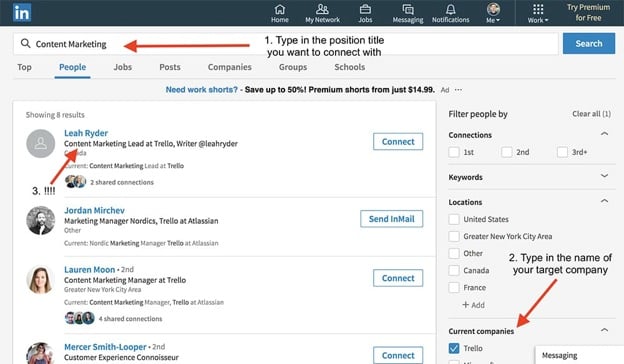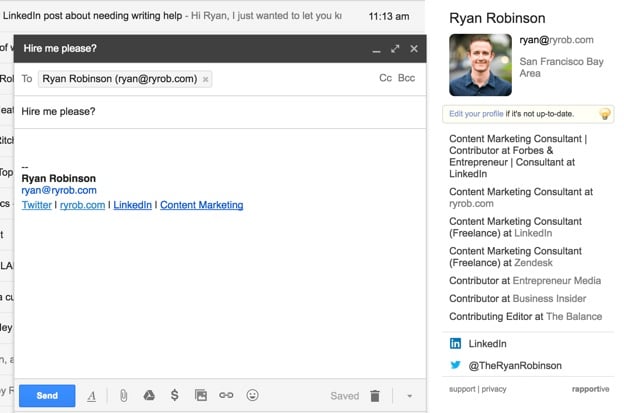Like it or not, there’s both an art and science to learning how to write cold emails that predictably convert new freelance clients. Today we’re talking about both, using my real cold email templates that have generated over $107,500 so far this year for my freelance business. You can pick up all of my copy and paste templates here.
As much as I’d like to tell you there’s an easy-to-follow, clear formula for writing cold emails that land new business every single time, the reality just isn’t that simple.
You have to test, iterate and adjust to the reactions your emails get out in the real world. Investing the time to perfect my cold outreach process has done a lot for my freelance business. However, not even the best cold email will get you a response if you’re pitching the wrong type of client or a point of contact who’s not empowered to take action on hiring you. Context is everything when you’re pitching new freelance clients—especially with cold emails.
Identifying the right clients
If the majority of your experience is in writing about finance or real estate, it doesn’t make much sense for you to pitch a company in the healthcare space on your freelance writing services.
Choose only to approach clients that you could picture yourself working with. If you don’t resonate with their brand, style and tone, leave it be. You’ll be able to deliver better work elsewhere.
Start with the people you know first. As much as I love cold emails, warm introductions are significantly more effective, so begin there. Look first to these groups of people within your network to determine if there are any freelance opportunities to work with those who already know your work ethic, are personally invested in their relationship with you and want to see you succeed:
- Friends (and their friends)
- Family (and their friends)
- Previous co-workers who now work elsewhere
- Classmates from school
Regardless of the exact role your connection has within the company they’re at, if that company could be a good fit for you to pitch about freelance work—that’s a great opportunity to chase down. Pick up the phone to catch up, grab coffee and ask if they’d be willing to introduce you to the right person within their organization for chatting about helping out on a freelance basis.
At the very least, walk away from these conversations with the name for who you should be reaching out to—then you can work your cold email magic. Let’s talk about getting your cold email right in front of the decision-maker.
Related: 3 Innovative Ways to Strengthen Your Email Marketing Pre-Launch
Finding your ideal point of contact
When I’m trying to land a new freelance client, I don’t want to spend time convincing a gatekeeper on the company’s HR or recruiting team that I’d be the best for the job—I’m going straight to the decision-maker that’s empowered to hire me for a gig.
You’ll want to go for a manager-level point of contact. The type of person who will have a say in hiring contractors for your discipline. Sometimes, if you can’t find a manager point of contact, making an initial (genuine) connection with someone who’s a staff writer (or designer, engineer, etc.) can lead to an introduction up the chain to their manager if you’re able to provide a significant amount of value in your cold email outreach.
Open up a new tab and head over to LinkedIn. In the main search bar, type in the title of the position you want to connect with—choose to display results for people with that job title or skill. Then, you can filter those results by people only with that job or skill at the company you’re targeting, by typing in that company’s name within the current company field. Now, your results will be hyper-specific.
If I want to land Trello as a content marketing client, my search would look like this:

Naturally, this works best for companies within a certain size range. If they’re on the smaller side, you might not immediately find a very clear point of contact. Same goes for enterprise-size companies that have dozens of potential points of contact. Make your best guess and keep moving rather than getting hung up or spending more than five minutes at this stage.
Getting their email address
Now that you have the name of your ideal point of contact, let’s get their email address.
Start by installing the free Rapportive Chrome extension for Gmail. A free tool owned by LinkedIn, Rapportive will add a new sidebar inside of your Gmail account that looks like this:

Now, when you type in a suspected email address for someone you want to reach out to, and hover your mouse over it, the Rapportive sidebar will populate a bunch of information about the person right in your inbox—if this email address is at all connected to their LinkedIn account.
If the sidebar appears and pulls in what looks to be the right person’s photo and description, you’ve got the right email address.
Cycle through testing the most popular email formats and verifying with Rapportive.
Nine times out of ten, you’ll get their email address in less than a minute of this and it’ll be in one of the above formats. If you’re not able to verify their email address with this method, find them on Twitter to see if they have contact information (or chase a link to their personal blog that might have their contact info).
Once you have your target’s email address, you’re ready to move into writing your cold email and formulating a winning proposal for them.
Choosing your template and outreach approach
First things first: Every sales training process I’ve ever gone through has taught me that you need to use the tools you have at your disposal—and not make excuses for why you can’t land a particular client.
If you go above and beyond to become a problem-solver and wow a prospect that you’ve really been wanting to work with, you can make it happen. It’s in your power.
Now, let’s dive into the email templates I’ve honed over the years.
Cold email template #1: Your feature on my blog
This first cold email template—specifically crafted for business influencers and startup founders—is built around using my blog as a way to provide value before I ask for anything in return.
Here’s how the process works:
- Ask for a quote to include in an upcoming article they’d want to weigh in on
- Publish my blog post with their quote, promote it heavily and get them traffic
- Reach back out to update and thank them for contributing to the post
- Highlight early success in that email (number of social shares, traffic, any features on publications)
Subject Line: Your feature on my blog
Body: Hey [First Name],
I’ve been a fan of what you’ve been doing with [Company Name] over the past couple of years.
I’m reaching out because I’m working on a new piece geared toward [topic of the blog post you’re writing] from those who’ve already been through this experience themselves and I’d love to hear your take on it. The post will be published to my blog [optional—that gets x number of readers] and I’d love to get a quick quote from you to include in the piece if you’re up for it.
If you’d be able to answer this question in a few sentences, that would be amazing:
[Relevant question/challenge that will give them an opportunity to showcase their expertise]? How do you advise people on overcoming that challenge?
[Your Name]
…
Your goal is to provide value and show your worth, which believe it or not, is a core part of any winning sales tactic. Because by doing that first, instead of just making promises of the value you could deliver in the future, you’re going to win their trust and catch their attention in a much different way than 99 percent of other freelancers cold emailing and pitching them to be hired.
It seems simple, but almost nobody has the patience to execute this kind of strategy. And because of that, so many freelancers waste a lot of time writing cold emails that get no response, largely because they’re being too shortsighted.
Cold email template #2: The direct approach
The next cold email template is much more direct, and as such, it is in my experience a little more likely to get turned down or go unanswered if there’s not an immediate need (or interest) internally at the company.
However, this email still provides real upfront value (our recurring theme).
Here’s how the process works:
- Identify your target contact and get their email address
- Find something relevant of theirs to share on social (bonus: also mention on your blog or Medium)
- Cold email referencing your share and mention
- Include a soft pitch for your services and ask if they’re up for chatting more
The email template goes like this…
…
Subject Line: [Company Name] [Service] (and mention)
Body: Hey [First Name],
I wanted to reach out and give you a heads up that I’ve been loving the [your service medium] coming out of [Company Name] these past few months. I can appreciate great [your service medium] when I see it 🙂
Just shared your recent [post, project, design, re-branding work, app, etc.] about [xyz] with my audience on Twitter and I also mentioned the platform as a great resource in one of my recent blog posts [link].
The other reason I’m reaching out is because a large part of my business is working with brands like [reference any relevant past clients or even full-time gigs] and others to help scale [your core service offering].
Would you be up for chatting about [Company Name’s] [your core service offering] or connecting me with someone else on your team if that’d be a better fit?
[Your Name]
P.S. Here’s where you can read more [link to portfolio page if possible] about my process and the clients I’ve worked with.
…
Of all the cold emails, this one is heaviest on self-promotion—in the context of building your authority with this potential client. It also directly pitches them on working together in your first email.
Sign Up: Receive the StartupNation newsletter!
Cold emails: bringing it all home
Out of the roughly 100 cold emails I’ve sent in the past year, somewhere in the neighborhood of 10 to 15 have materialized into deals within a month of initial contact.
This selling approach also requires more hands-on follow up too, which often means a couple rounds of follow up before getting to next steps. But what’s really great about this approach is that you’re now on their radar.
Even if you don’t immediately land a gig, you have an opportunity to stay top of mind over time.






